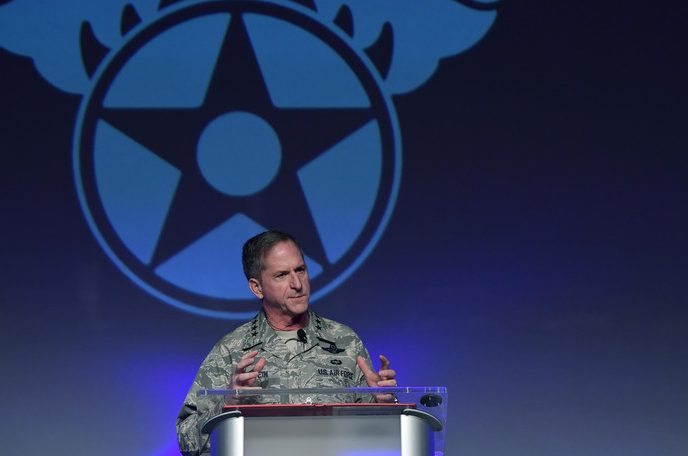
Air Force Chief of Staff Gen. David Goldfein
AFA 2020: The next exercise of the Air Force’s Advanced Battle Management System (ABMS) will focus on a first: supporting Space Command (SPACECOM) through a simulated attack on US space assets, Air Force Chief of Staff Gen. David Goldfein says.
“We’re going to have three supported commanders, one for the very first time in history. The US Space Command Commander Gen. Raymond is going to be the supported commander for this activity,” Goldfein told me in an exclusive interview here in Orlando on Feb. 27. All the Joint Chiefs of Staff plan to attend this exercise.
US operational commands, called Combatant Commands, are broken down into two types: those covering ops in a geographic area, such as European Command, that are supported commands; and so-called functional commands that provide cross-regional capabilities, such as Cyber Command, that are supporting commands.
As Breaking D readers know, the new(ish) Space Command was deliberately organized as a geographic command — its region being 100 kilometers above the Earth and beyond — in order to allow it to be a supported command. Indeed, Gen. Jay Raymond, who is double hatted as head of both SPACECOM and the Space Force, pushed strongly for that to happen.
“We normally sort of look at him [Raymond] as the supporting commander, but, now, he will be the lead supported commander. There will be actions taken against his assets, and we will have to use all-domain command and control to generate an all-domain response to that.”
Besides SPACECOM, Goldfein said, the exercise will include Northern Command (NORTHCOM), headed by Gen. Terrence O’Shaughnessy, and Strategic Command (STRATCOM) now led by Adm. Chas Richard.
“We’ll shift to a scenario with Gen. O’Shaughnessy as the supported commander, and he will have a combination cruise missile and bomber attack, and we will have to generate very quickly an all domain response to be able to counter that,” he explained. “And then we’ll have a scenario that supports the STRATCOM commander,” involving “attacks on his nuclear command and control (NC3)” and designed to figure out how to ensure “continuity” using JADC2 at the top of the military food chain.
The April 8 exercise is the second of the ABMS family of systems being designed to enable the multi-service Joint All Domain Command and Control (JADC2) concept to link every sensor to every shooter via a military Internet of Things. It will be much larger than the first so-called “ABMS OnRamp” exercise, held Dec. 16-18 in Florida,
It will involve the Air Force, Army, Navy and Space Force, and span a large number of bases from Eglin AFB, Florida; Nellis AFB, Nevada; Yuma Proving Ground, Arizona; and White Sands Missile Range, New Mexico.

Advanced Battle Management System Overview
“The next one we’re doing is big. It’s big,” Goldfein said. “I’m anticipating a 60 percent success rate, because we are going to fail fast and learn.”
Goldfein said that as these ABMS exercises continue every four months, they will make concrete what just a year ago or so was really a concept on paper — moving from “aspirational Power Point lightning bolts to real capability.” He said that because the service has been able to develop real things — including “cloudONE” and the “dataONE” data library that evolved from the Air Force’s Unified Data Library for space object data — “all the services are playing with us now.”
The four-month cycle is key to allowing the Air Force and its sister services to actually test technologies that can provide connectivity, he said, via a spiral development cycle that builds new capability with each bite the service takes of the problem.
“Some advice I got early on in this journey was: ‘Hey, don’t eat the entire elephant. It’ll crush you with its own weight. So pick an edible animal.’ So, we jokingly called it the gazelle,” he said with a laugh.
“We don’t connect everything” at once, he explained. “We take some elements of the force, the joint force, and we connect them. And we pick a problem to solve, or two or three. Then we go give it a shot.”
Goldfein said the four-month cycle of exercises also is helping to make ABMS, and in turn JADC2, more concrete in the eyes of a skeptical Congress. DoD asked for total of $302 million in 2021 for ABMS, more than double the $144 million Congress granted in 2020 — a figure slightly smaller than the service’s 2020 request of $186 million, and one that came with a bucketload of reporting requirements.
“You’re right that we haven’t perhaps made the case, but let’s also be honest that a lot of the case we were making before was aspirational Power Point. Now I’m sitting down with Congress and showing them, look what we accomplished this last time, and we’re on the next four month demo,” he said. “Every four months we’re making it real.”
He added that all five members of the joint chiefs are fully behind JADC2, and are participating in the ABMS effort. That should be another factor in helping bring Congress around on funding. “It may be the Air Force has got the most invested at this point, but this is joint. The J matters,” he said.
Move over FARA: General Atomics pitching new Gray Eagle version for armed scout mission
General Atomics will also showcase its Mojave demonstrator for the first time during the Army Aviation Association of America conference in Denver, a company spokesman said.


























